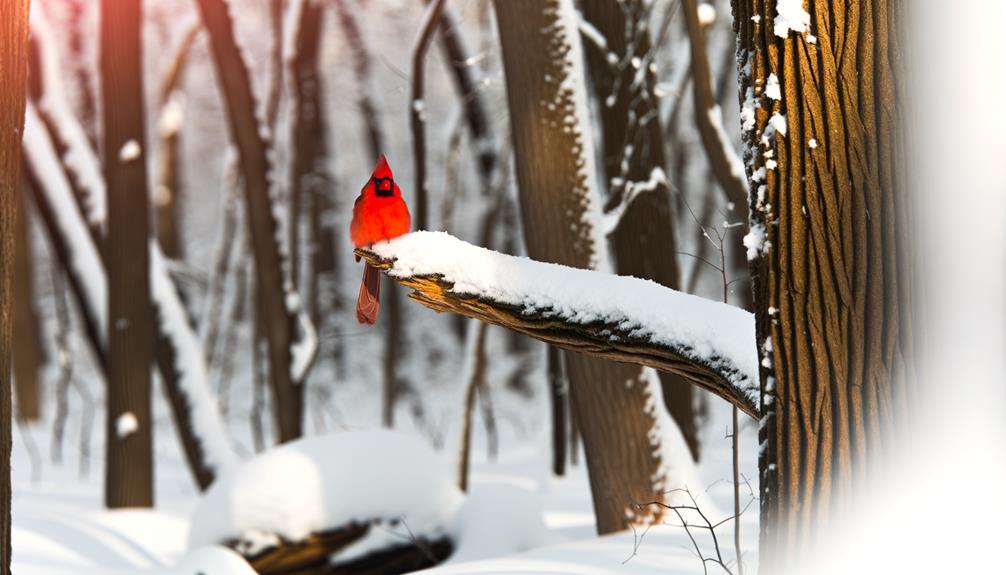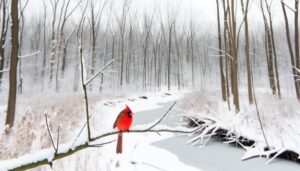How to Understand How Long Do Northern Cardinals Live
Northern Cardinals typically live between three to five years, although some individuals can reach up to fifteen years. Detailed banding studies and observations support these findings.
Predation from cats, hawks, and snakes, along with diseases like avian pox and West Nile virus, greatly influence their lifespan. Cardinals thrive in dense shrubbery and edge habitats, which provide shelter and food.
Urban areas contribute to their survival, though habitat fragmentation poses challenges. Understanding these factors, including the role of habitat and threats, is vital for conservation.
Monitoring and tailored conservation strategies are essential for those interested in their longevity.

Key Takeaways
- Northern Cardinals have an average lifespan of three to five years.
- Some Northern Cardinals can live up to fifteen years under optimal conditions.
- Predation and diseases significantly impact Northern Cardinals' lifespan.
- Quality habitat and food availability are crucial for Northern Cardinals' longevity.
- Urban areas and gardens can enhance survival rates for Northern Cardinals.
Average Lifespan

The average lifespan of a Northern Cardinal in the wild typically ranges from three to five years, although some individuals have been documented living up to fifteen years. Detailed banding studies and long-term observations support these findings.
Most cardinals face numerous challenges in their natural habitats, which can limit their longevity. Data collected from various avian research programs suggest that while the majority of these birds don't surpass the five-year mark, exceptional cases exist. These outliers are often attributed to favorable environmental conditions and genetic factors.
Scientific literature emphasizes the importance of ongoing monitoring to better understand age distribution and survival rates among Northern Cardinals. Such research is essential for developing effective conservation strategies and ensuring the species' continued health.
Factors Affecting Longevity
Several factors heavily influence the longevity of Northern Cardinals. These factors include predation, disease, habitat quality, and availability of food resources. Predatory threats for these birds include domestic cats, hawks, and snakes. Diseases such as avian pox and West Nile virus can significantly diminish their lifespan. The quality of habitat impacts their exposure to harsh weather and availability of shelter.
Key factors include:
- Predation: Increased risk from domestic cats, hawks, and snakes.
- Disease: Susceptibility to avian pox and West Nile virus.
- Habitat Quality: Protection from harsh weather and adequate shelter.
- Food Resources: Availability of seeds, fruits, and insects.
These factors, individually or combined, play an essential role in determining the lifespan and survival rates of Northern Cardinals.
Role of Habitat

Best habitat plays a vital role in determining the survival and reproductive success of Northern Cardinals. These birds thrive in areas with dense shrubbery and abundant foliage, which provide essential cover and nesting sites.
Studies show that cardinals prefer edge habitats, where forests meet open fields, enhancing their foraging opportunities. Research indicates that urban and suburban areas, with plentiful bird feeders and shelter, contribute to higher survival rates.
Cardinals' adaptability to various environments, including gardens and parks, supports stable populations. However, habitat fragmentation can limit access to resources, negatively impacting longevity.
Ensuring diverse, undisturbed habitats with adequate food sources and nesting sites is crucial for sustaining healthy Northern Cardinal populations over time.
Predation and Threats
Predators such as hawks, owls, and domestic cats pose significant threats to the longevity of Northern Cardinals. These birds face various dangers in their natural habitats that can shorten their lifespan. Predation isn't the main threat; other factors worsen their vulnerability.
- Hawks: Often seen swooping down to snatch unsuspecting cardinals.
- Owls: Silent hunters that strike during the night.
- Domestic cats: Known for their tendency to hunt birds in residential areas.
- Snakes: Slither into nests, preying on eggs and fledglings.
Evidence shows that predation accounts for a substantial portion of cardinal mortality. Detailed observations indicate that cardinals' bright plumage makes them more noticeable to predators, further increasing their risk.
Understanding these threats is essential for comprehending their survival dynamics.
Increasing Lifespan

Implementing effective conservation strategies can greatly increase the lifespan of Northern Cardinals. Research indicates that providing best-suited habitats, including native plant species, enhances survival rates.
Environmental modifications, such as reducing pesticide use, can also mitigate risks from toxic exposure. Studies have shown that supplementary feeding, especially during winter months, improves their overall health and longevity to a large extent.
Additionally, community education campaigns that focus on predator control, primarily domestic cats, have proven beneficial. Establishing bird-friendly urban environments with adequate shelter and nesting sites further supports their well-being.
Conclusion
To sum up, northern cardinals, with a typical lifespan of 3-5 years, face numerous challenges that influence their longevity.
For instance, a well-documented case revealed that a cardinal lived up to 15 years in a predator-free environment, akin to a rare gem hidden away from the ravages of time.
This exceptional longevity underscores the profound impact of habitat quality and predation. Therefore, optimizing these factors is crucial for extending their lives and preserving their vibrant presence.






